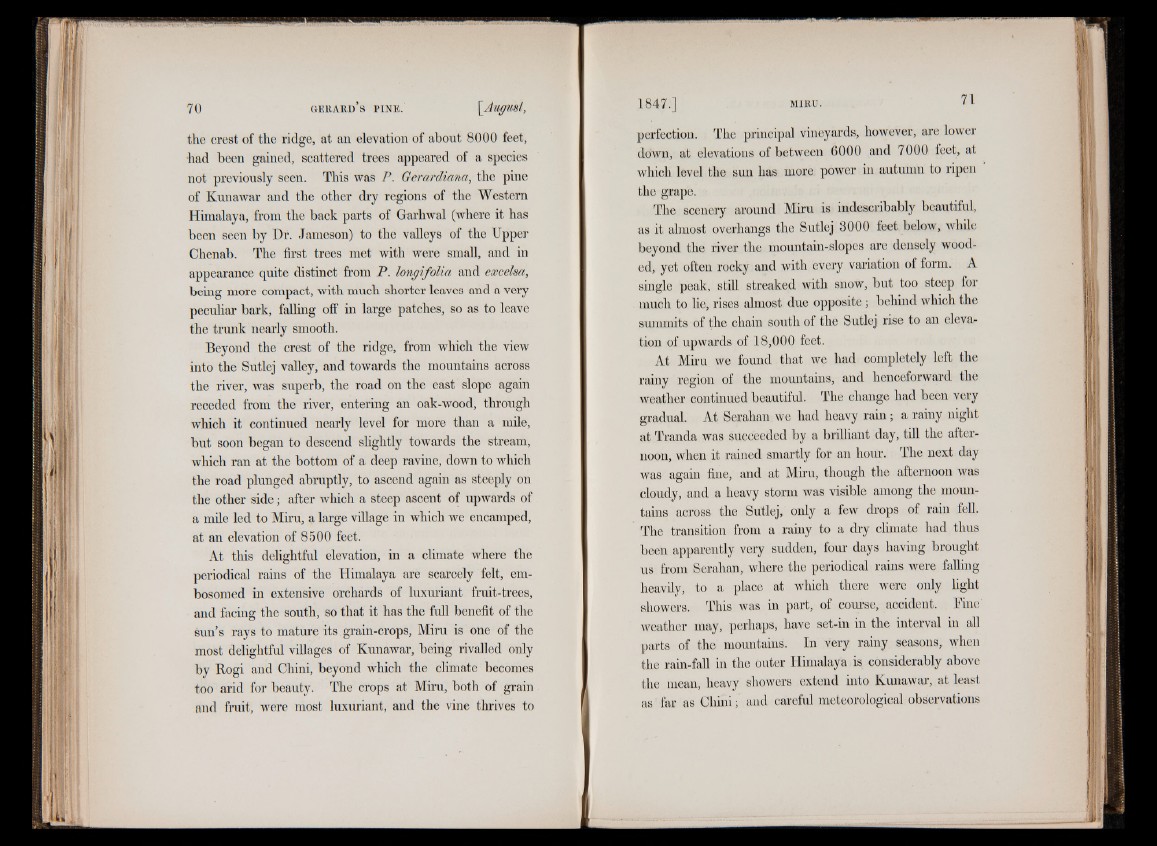
the crest of the ridge, at an elevation of about 8000 feet,
had been gained, scattered trees appeared of a species
not previously seen. This was P. Gerardiana, the pine
of Kunawar and the other dry regions of the Western
Himalaya, from the back parts of Garhwal (where it has
been seen by Dr. Jameson) to the valleys of the Upper
Chenab. The first trees met with were small, and in
appearance quite distinct from P. longifolia and excelsa,
being more compact, with much shorter leaves and a very
peculiar bark, falling off in large patches, so as to leave
the trunk nearly smooth.
Beyond the crest of the ridge, from which the view
into the Sutlej valley, and towards the mountains across
the river, was superb, the road on the east slope again
receded from the river, entering an oak-wood, through
which it continued nearly level for more than a mile,
but soon began to descend slightly towards the stream,
which ran at the bottom of a deep ravine, down to which
the road plunged abruptly, to ascend again as steeply on
the other side; after which a steep ascent of upwards of
a mile led to Miru, a large village in which we encamped,
at an elevation of 8500 feet.
At this delightful elevation, in a climate where the
periodical rains of the Himalaya are scarcely felt, embosomed
in extensive orchards of luxuriant fruit-trees,
and facing the south, so that it has the full benefit of the
sun’s rays to mature its grain-crops, Miru is one of the
most delightful villages of Kunawar, being rivalled only
by Rogi and Chini, beyond which the climate becomes
too arid for beauty. The crops at Miru, both of grain
and fruit, were most luxuriant, and the vine thrives to
perfection. The principal vineyards, however, are lower
down, at elevations of between 6000 and 7000 feet, at
which level the sun has more power in autumn to ripen
the grape.
The scenery around Miru is indescribably beautiful,
as it almost overhangs the Sutlej 3000 feet below, while
beyond the river the mountain-slopes are densely wooded,
yet often rocky and with every variation of form. A
single peak, still streaked with snow, but too steep for
much to lie, rises almost due opposite; behind which the
summits of the chain south of the Sutlej rise to an elevation
of upwards of 18,000 feet.
At Miru we found that we had completely left the
rainy region of the mountains, and henceforward the
weather continued beautiful. The change had been very
gradual. At Serahan we had heavy rain; a rainy night
at Tranda was succeeded by a brilliant day, till the afternoon,
when it rained smartly for an hour. The next day
was again fine, and at Miru, though the afternoon was
cloudy, and a heavy storm was visible among the mountains
across the Sutlej, only a few drops of rain fell.
The transition from a rainy to a dry climate had thus
been apparently very sudden, four days having brought
us from Serahan, where the periodical rains were falling
heavily, to a place at which there were only light
showers. This was in part, of course, accident. Bine
weather may, perhaps, have set-in in the interval in all
parts of the mountains. In very rainy seasons, when
the rain-fall in the outer Himalaya is considerably above
the mean, heavy showers extend into Kunawar, at least
as far as Chini; and careful meteorological observations